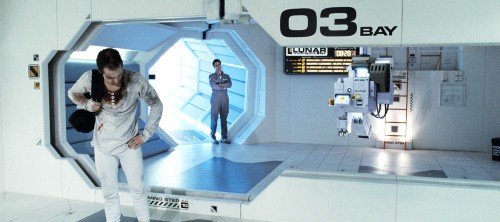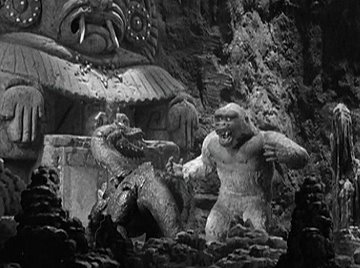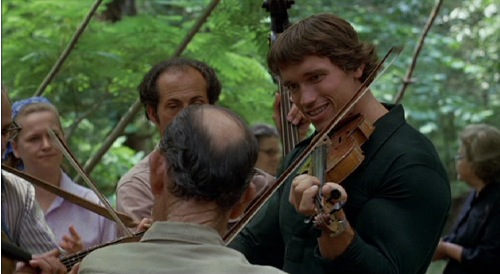The title of this entry doesn’t mean what you probably think I mean. Read on to see what I’m really getting at.

The Girlfriend and I finally made it to see Pirates of the Caribbean: On Stranger Tides yesterday. I say “finally” because we’ve tried several times over the past couple of weeks to catch the latest installment of the franchise, but for various reasons we did not succeed on our earlier attempts. So, you may be wondering, was the wait worth it? Well, yes, I would say so. Despite the generally mediocre reviews, Anne and I thoroughly enjoyed ourselves. There’s a new director this time out — Rob Marshall took the helm from Gore Verbinski, who helmed the first three Pirates movies — and the change seems to have made a tremendous difference, especially in the action scenes, which are actually comprehensible in Stranger Tides. (That’s a big, BIG deal for me. I do not like the jittery, super-fast editing style where you lose track of who is doing what, and although the earlier Pirates movies never rose to the ridiculous level of the Bourne movies — i.e., total incomprehensibility — they flirted with it enough that I was frequently frustrated with them.)
This Pirates is smaller in scope than the wanna-be-epic second and third installments, a lot of extraneous characters from the “original trilogy” have been pared away, and the whole thing just feels much lighter overall. Like the other films in the series, it’s too bloody long. (How is it that Errol Flynn managed to get all his swashbuckling done in roughly 90 minutes, but modern-day pirates need two-and-a-half hours?) However, I can’t recall squirming in my seat or checking my watch once. I pumped my fist and/or laughed out loud a number of times. The sequence in which Captain Jack escapes from King George’s palace and tears off through the streets of 18th-century London with the redcoats in pursuit is as much fun as I’ve had at a movie in years. (That sequence also includes an unexpected and delightful cameo from the ever-lovely Dame Judi Dench, who always makes me happy.) Surprisingly, after four movies, On Stranger Tides still manages to produce a couple grin-inducing references to the Disneyland ride that inspired this whole thing. And Penelope Cruz dressed in pirate clothes is nothing less than a force of nature. So, yeah, I recommend it. It’s not a perfect movie by any means, but it is what a pirate movie ought to be, namely a nice bit of summertime escapism from the dreary, slow-motion horror that is 21st century.
You wanna know what really made me happy about Pirates 4, though? This is probably going to sound very strange, but it is what it is… I found I was irrationally pleased to see a pattern of flickering horizontal scratches along the right side of the screen throughout the entire length of the movie. As a former projectionist, I spotted them instantly, and knew exactly what caused them. Once upon a time, scratches like that on such a relatively new film would’ve driven me crazy. Anathema! My job back then, and my quest as a viewer, was to achieve a perfect presentation, or as close to perfect as you could get with a strip of easily damaged celluloid sliding through a whirring, spinning, film-shredding mechanical gauntlet. In recent years, we’ve finally achieved perfection in the form of digital projection technology: a digitally projected movie is always crystal clear, always clean, the same after 1,000 or even 10,000 screenings as it was on the very first one. But that has created a different kind of problem, at least for me. Yes, I’m going to say exactly what my Loyal Readers are anticipating. Something has been lost in the change to digital projection. Movies don’t look like films anymore, if that makes sense. They no longer have the imperfections that used to be part of the experience: the film grain and dust specks and scratches and all the other stuff we tried so hard to eliminate. It’s arguably not the same art form any longer, because the medium is so utterly different now.
Seeing those scratches on Pirates 4 was a dead giveaway that I was watching actual film, that there was a human being up there in the booth threading a strip of celluloid through the rollers and sprockets and gates before every show, and not just a computer that turned everything on at the appointed time. The projectionist had made a mistake at some point and damaged the print, true, but those platter scratches (not to mention the eruption of scratches and garbage around one of the reel changes!) were organic to the medium, and weirdly enough, I did enjoy seeing them. It made me realize how much I miss scratches and hairs stuck in the gate and juddery splice marks and the “cigarette burns” that used to signal the end of a reel, and all the other artifacts of the Way Things Used to Be that have been lost since everything became just another variety of computer.
Pirates of the Caribbean: On Stranger Tides was a good movie, yes, but it was also a good film, in the literal sense. And it was really wonderful to see one again. At least it was for me… your mileage may vary.
 I’m a few years behind in seeing Moon, the 2009 indie science-fiction film directed by Duncan Jones (son of David Bowie!), but wow, what a great little movie. Sam Rockwell, perhaps best known for Galaxy Quest and Confessions of a Dangerous Mind, turns in a bravura performance (or is that two performances?) in a virtual one-man show about the lone occupant of a lunar mining base who’s beginning to question his sanity as the end of his three-year tour approaches. It’s essentially a character study wrapped up in a mystery story that brilliantly expands on some of the ideas explored in my beloved Blade Runner — specifically questions of identity and whether we can trust our own memories, and what a person might go through emotionally when those things turn out to be… unreliable. I feared for a time that this was going to turn into one of those “mindf**k” stories that I have so little patience for, but in the end all is explained and logical and satisfactory. It’s a moving, very human story with plausible sci-fi underpinnings. And honestly, I think Moon looks every bit as good as this year’s Prometheus in terms of production design and FX, and it was done on a fraction of the budget using old-school miniatures instead of CGI.
I’m a few years behind in seeing Moon, the 2009 indie science-fiction film directed by Duncan Jones (son of David Bowie!), but wow, what a great little movie. Sam Rockwell, perhaps best known for Galaxy Quest and Confessions of a Dangerous Mind, turns in a bravura performance (or is that two performances?) in a virtual one-man show about the lone occupant of a lunar mining base who’s beginning to question his sanity as the end of his three-year tour approaches. It’s essentially a character study wrapped up in a mystery story that brilliantly expands on some of the ideas explored in my beloved Blade Runner — specifically questions of identity and whether we can trust our own memories, and what a person might go through emotionally when those things turn out to be… unreliable. I feared for a time that this was going to turn into one of those “mindf**k” stories that I have so little patience for, but in the end all is explained and logical and satisfactory. It’s a moving, very human story with plausible sci-fi underpinnings. And honestly, I think Moon looks every bit as good as this year’s Prometheus in terms of production design and FX, and it was done on a fraction of the budget using old-school miniatures instead of CGI.



